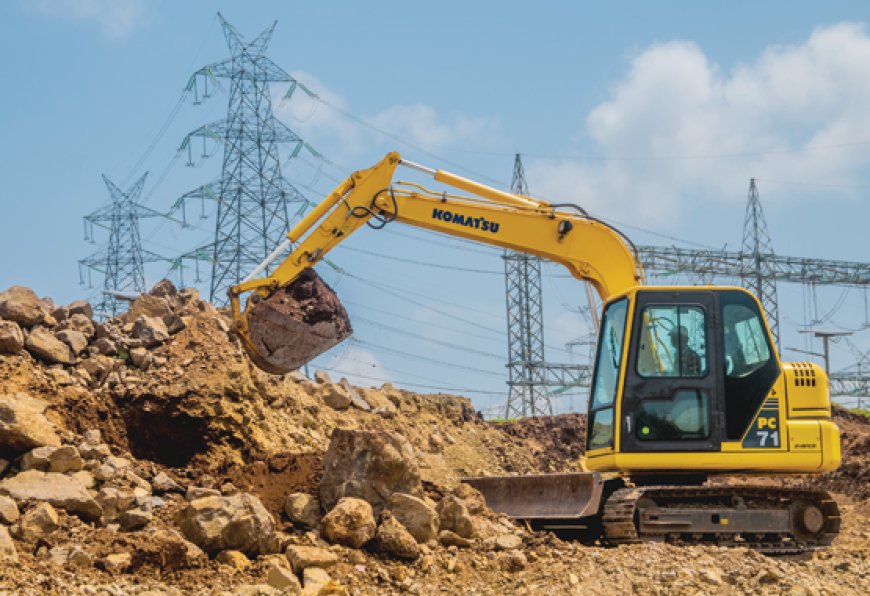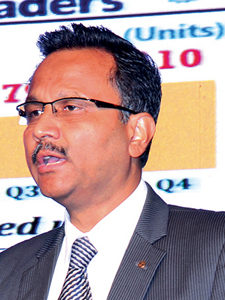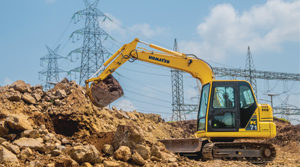Ecology, economy and technology are at the core of the ecot-3 series.
Vivek Hajela General Manager & Head Construction Equipment Business Larsen & Toubro Limited Komatsu has refined the engine technology, hydraulic technology and electronic technology to provide economy to customers while keeping impact on ecology to the minimum by abiding by

 Vivek Hajela
Vivek Hajela
General Manager & Head
Construction Equipment Business
Larsen & Toubro Limited
Komatsu has refined the engine technology, hydraulic technology and electronic technology to provide economy to customers while keeping impact on ecology to the minimum by abiding by the current emission norms.
How do you evaluate the conceptual shift from even concepts like lifecycle cost and TCO towards ‘more productivity’?
Productivity was always the most important yardstick for evaluating machines by customers who were using it for production-intensive applications like irrigation projects, roads, railways, and quarrying, where completion time was the essence. In fact, what customers need is the lowest cost of production. Hence, TCO divided by total production equals cost of production. As a result, TCO and productivity cannot be delinked.
 With increase in mechanization, where machines found application in less production intensive areas that customers started considering low-cost machines and lessened their focus on productivity. Customers in the hiring sector consider L/hr only, while Tones/ Litre or Cum/lit of fuel is an appropriate measure of machine performance.
With increase in mechanization, where machines found application in less production intensive areas that customers started considering low-cost machines and lessened their focus on productivity. Customers in the hiring sector consider L/hr only, while Tones/ Litre or Cum/lit of fuel is an appropriate measure of machine performance.
What is the impact of this on a company like L&T while designing/ or bringing out new features/models into the market?
Komatsu machines that L&T sells and supports relied more on its productivity and reliability even at the time when electronic intervention was not highly evolved. Getting back to productivity feature is no surprise, as you can always produce less if you want, but you cannot produce more if you are not capable of. Komatsu has never compromised on productivity capability, but had added features which have made the machines more efficient and energy saving.
For example, the P mode is production Priority mode, where the hydraulics is set for faster cycle times and E mode targets for good productivity and has fuel saving priority. Even E mode has four sub-modes to fine-tune the engine and hydraulics as per the job at hand.
What are the challenges here as the shift seems to be market/customer driven, not OEM driven?
Customers’ need, was and will always be the source of input for development of new machines as necessity is still the mother of invention. However, today manufacturers are also bound by regulation emissions, safety, etc.
Komatsu places ecology, economy and technology at the core of the current series of machine design, – ecot-3 series. Komatsu has refined the engine technology, hydraulic technology and electronic technology to provide economy to customers while keeping impact on ecology to the minimum by abiding by the current emission norms.
The only challenge is that the machines are becoming more expensive and some customers feel at ease to opt for cheaper ones. Needless to say that economy machines with older technology will still be able to sell in nos. where the onus is not on productivity and reliability. This may not continue in the long run, and suddenly there will be a steep rise in prices when regulations become binding.
Brief us on the engine technology in-built in your latest range of excavators?
Emission regulations are driving engine technology worldwide. Today off-road engines need to meet EPA Tier-III norms. High pressure injection, variable injection timing, variable injection pressure, air to air aftercooler and electronically controlled high-pressure common rail fuel system is being used to control NOX, CO and particulate matter. On large-sized engines, Komatsu also uses EGR (Exhaust Gas recirculation). For example, the PC210-8 M0 uses HPCR fuel system with air to air aftercooler. Operators get the support of auto deceleration features that automatically reduces engine rpm if the machine is idle – a good tool to save fuel.
Is there a shift towards electronic engines?
Electronically-controlled engine is the answer to the emission requirement and all manufacturers will ultimately have to move towards electronic engines, once the emission norms for track type equipment in India are in place. Today, this is applicable for wheel type machines in the sub 700 HP range. (Fuel consumption per say (l/hr.) may not reduce with increase in emission standards. However, the rate of increase of fuel consumption with increase of emission standards will decrease.
Could you elaborate us on the design improvements to the hydraulic system that boost fuel efficiency?
Hydraulic power output plus hydraulic system losses are equal to the engine power input to hydraulics. Therefore, engine remaining constant, the hydraulic losses in the system will reduce fuel efficiency. (Converting fuel into cubic meters of material in the hauling unit). Hydraulic system development is thus an attempt to reduce losses in the system. CLSS hydraulic system patented by Komatsu as HydrauMIND is the latest and has no permanent neutral loss, and delivers exact flow on demand. To reduce line losses, the latest machines have large diameter pipelines. Modern machines have variable backpressure valve whose value depends on the operational requirement. The pump has two separate electronic control valves, to control the pump flow independently with the control valves having the merge – divide function. These elements reduce losses in the system and in turn enhance productivity thereby improving fuel efficiency.
From the design perspective, how have you ensured better productivity and faster cycle times in terms of better breakout force and arm tear out force?
Speed is a function of flow if the cross-sectional area of cylinders is constant, and force is a function of pressure. Pressure is created by load resistance and is dependent on material density. If you compare the latest PC210 with the discontinued PC200-6, the maximum working pressure is increased from 320 Kg/cm2 to 380Kg/cm2. This is certainly going to enhance the bucket penetration force and digging time will reduce, enhancing productivity.
Bucket Cut Depth (BCD) and RPM settings can affect fuel efficiency and productivity. What is your take on this, especially this is in the hands of the operators
Absolutely correct, operator is the key to extracting the maximum output from the machine. Manufacturers can build the capacity to produce, which a trained operator can use correctly to derive the output to the fullest. Operators’ skill will certainly play a role and so does operator training, so that he uses the features available appropriately and get max output. Today, machines are equipped with tracking devices that monitor machine parameters and can find out if the machine performed poorly or the operator.
What is the impact of telematics and data-driven solutions in bringing down fuel consumption and enhancing productivity?
Telematics has already created an indelible positive impact in the industry. Usage of an expensive asset has to be monitored and telematics is the solution. Komtrax used on Komatsu machines provide remote machine tracking and the owner can remain connected to the machine from any corner of the country. Komtrax captures the working time, differentiate between working and idling time and even the operating mode. More importantly it can identify the operator’s skill and the site condition by keeping a count of the relief operation and the average pressure in the system. Operators receive real time eco-guidance and operational cautions in machine monitor. Instantaneous fuel consumption or over a period is available on the monitor screen and operators can fine-tune their operating styles. Abnormalities and maintenance due is reported so that machine care is on time. In effect, machine owners and distributors can track each and every activity of the machine. This is an irreversible development and telematics will only be more profound and greater application.
Since there is a greater acceptance of ‘operator’ as a vital link in the whole system, correspondingly how the design trends have evolved, especially the cab design?
Operator output has a lot to do with his fatigue rate. In the first hour of operation, when the operator is fresh, output is more machine dependent than operator, but in the 4th hour of operation or the 7th and 8th hour output does get affected. Hence, cab should be ergonomically designed, that enhances safety and comfort level with reduced fatigue to the operators. Air conditioned cabs are gaining acceptance and the music system becomes the operators companion in the cab. The seat cushion can be adjusted according to the operator’s weight, to and fro seat movement takes care of his height. Even the arm rest can be adjusted to provide proper angle between the hand and the joystick. The reclining back- rest provides lumbar support which is the key to back and spine posture and has an impact on the fatigue induced due to seat design. These days a lot of thought goes in the cab design, right from the cab viscous dampers that isolate vibrations, sealing that keeps the outside sound away and even mirror positioning that ensures visibility of the work area and surroundings.
How do you assess the importance of ‘maintenance’ to fuel efficiency? What are the trends here?
There is a direct co-relation between maintenance and fuel efficiency. For example, if the fuel system maintenance is poor, then HPCR injectors will get worn out prematurely and injection quantity increases. This is visible in enhanced fuel consumption and poor exhaust gas colour. If air system maintenance is poor, the compression pressure gets adversely affected and hence the power delivered to the flywheel. Similarly, if lube oil is not of the correct grade the internal friction of the moving parts will get affected causing a reduction in the output thereby lowering of fuel efficiency. On the mechanical front, even greasing of pins and bushing, replacement of tooth points and use of genuine spare parts will effect fuel economy.
What is special in ‘service packages’ that you offer to help enhance productivity, and continued uptime of a machine?
Proper and on-time maintenance is the crucial element to enhance availability, reliability and durability of machines. This simple message is demonstrated through the machine care programme popularized as the ‘Suraksha’ scheme. When a customer enters into this scheme, he agrees to use Komatsu genuine oil and filters. In return the power train warranty is extended up to 9000 hours or 3 years. All mandatory services are carried out under the supervision of trained service engineers. Energy saving training and tips are provided to operator and maintenance team. Preventive maintenance checks like Komatsu undercarriage inspection is carried out and shared with the customer along with the PM report. This scheme insulates the owner from the impact of unexpected major component failure, and protects him when he has the responsibility of repayment of funds. This also eliminates the attraction of site supervisors to try and experiment low quality, low cost non-genuine filters that can only harm the machine. All this, in fact, is and sounds very simple, but requires a high level of discipline and commitment on the part of the service team to be available at the jobsite and execute.
What are the trends with regard to use of synthetic oils in excavators?
Komatsu does not recommend the use of expensive synthetic oil. It uses normal hydraulic oil, and follows 5000hrs oil change interval. Thanks to the hydraulic system that does not generate high contaminants or cause oil fatigue and the filtration system that keep the hydraulic clean for such a long time. The eco-white filters are not only efficient, they are also small in size and as a result remain above the oil level if the machine is parked in a predefined posture. Thus when removed for replacement, they come out dry making the replacement process clean and environment friendly.
What is the demand-supply scenario of excavators?
The HEX market grew by 40% in FY16-17 and 25% in FY17-18. The growth is expected to be 20% for FY18-19 and we expect the industry to touch 24,000 plus machines. At these levels, we expect the manufacturers to operate their facilities to their full capacity.
Currently, roads and general construction are the key demand drivers and the demand in these segments is growing at more than 30%. A growth in these segments is also driving the demand for aggregates. The quarrying activity is growing by 25%. The government continues to be focused towards infra development and infrastructure spending in FY1819 is expected to be 10% of GDP. We expect to have a healthy order book for the next couple of years.
What are the major challenges the CE industry is facing in today’s context?
The interest rate and cost of capital in the CE space continues to be high. The industry will have a better future if the government considers infra development as a priority sector and awards certain concessions on the cost of capital.
In addition, due to continuous increase in equipment sales over the last few years, there is a severe shortage of skilled manpower for both operation and maintenance of these machines. We have five training centers and are conducting a lot of skill enhancement programs. As equipment is becoming technologically advanced, a lot more needs to be done by the industry to meet the skill requirement of operating personnel. The other challenge is the high import content in these machines making them expensive.
What is your assessment on the latest budget with regard to its positive impact on construction industry and the CE industry?
The government continued its impetus on infrastructure sector with fund allocation increasing from USD 1.81 trillion in FY1415 to USD 5.97 trillion in FY1819, which is a significant jump. The collection of cess on petrol and diesel of Rs 8 / L will also help in generating funds for infra development. The ambitious Bharatmala Project, AIBP irrigation scheme etc. will open up big opportunity for equipment sellers. Allocation to railways and airports is also higher and this will lead to a very positive impact in the CE Industry.
Hits: 162








